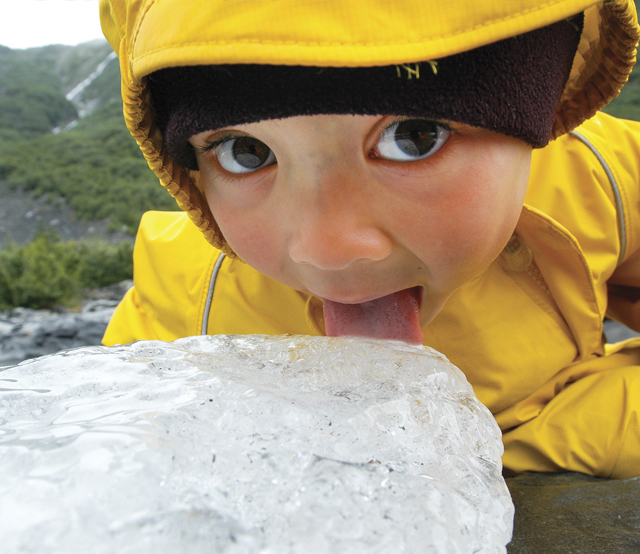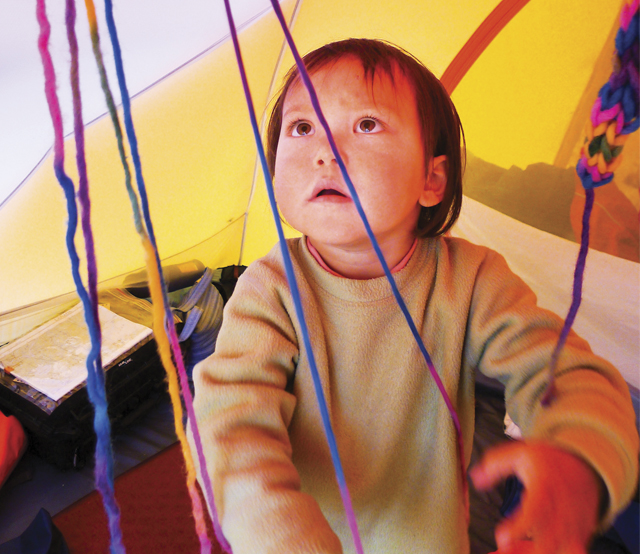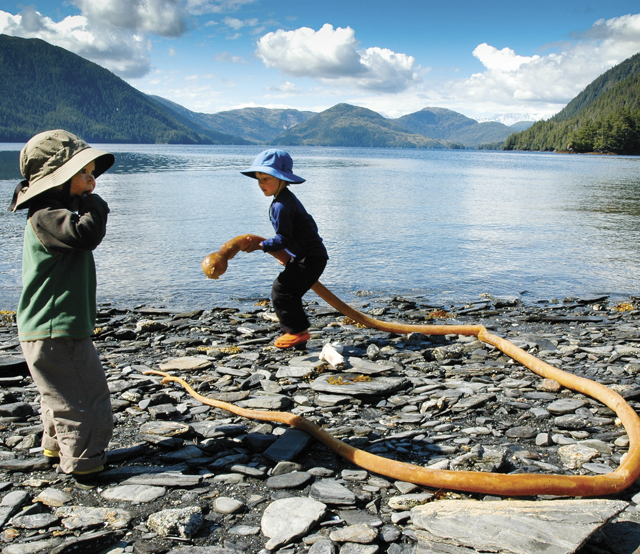A boat load of toys and electronics is not the picture of family canoe tripping that outdoor enthusiast parents envision. We want our kids actively engaged in their surroundings, having fun while busily discovering the natural world that compels us to get out canoeing in the first place.
After 6,000 kilometers of canoe tripping as a family, we have discovered a few tricks to help the kids settle into their wilderness playground. In our 500 plus nights of camping as a family, we’ve rarely had complaints. When we pause from paddling, the kids naturally drift off to play, figuring out the lay of the land in each new spot. If there is a definition of parenting bliss, this is it.
Photo by Dan Clark
PART OF THE PLANNING
Building a sense of anticipation is a great way to get kids involved in the trip. Start talking about it as a family weeks before you head out on your trip, look at some pictures of the area you intend to paddle and get kids to imagine what it might be like. Provide kids with a stuff sack that they can fill with a few favorite toys and encourage them to bring some books for time in the tent at the end of the day.
TOSS IN SOME TOOLS
If you want your kids to play with the elements surrounding them, some basics will enable them to get started with creative outdoor play. Reducing the toys that we pack may be one of the greatest challenges for parents planning canoe trips. We always pack things like a shovel, bucket, sponge, some plastic containers with lids, static cord and yarn. For older kids, a small knife can be an excellent addition.
SET SOME GROUND RULES
It is important to find a happy medium between helicopter parenting and letting your kids disappear into the rough. Young kids need close attention as they are less rational and may inadvertently wander away. However, once our kids are over four years old we developed a general rule: the kids should be able to see camp from wherever they are so that we are able to
see them. We also suggest the buddy system so that they look after on another. There are a few other considerations to keep everyone safe, such as making noise in bear country, and not picking and eating anything without parent approval.
Photo by Dan Clark
WATER, ROCK AND ICE
The inorganic that can be found in even the most barren Arctic landscapes is a veritable sandbox for kids to play in. With a few tools, they will soon be building dams and creating miniature rivers. Picture gumboots filled with sand and butterfly motifs etched in mud with a stick and you’re on the right track. Canoeing really is one big beach vacation, except that there is a new beach to explore around each bend.
Rock collecting is a great way to inspire treasure hunting. One way to inspire kids to focus on the small details is by reading, “Everyone Needs a Rock” by Byrd Baylor. This book shares some highly individualistic rules for finding the perfect rock. You can extend the learning by looking for crystals in rocks, seeking that perfect heart-shaped stone, or the ideal skipping stone. When we are outside of National and Provincial Parks (where you are not allowed to remove anything), our family usually returns with a weighty stuff sack full of special rocks that grace our nature table in our kitchen. These keepsakes help connect kids to nature and provide lasting memories for the entire family.
PLANTS
You don’t need a degree in botany to help your kids learn about the plants that surround your family. You may start by bringing a plant guide, and laminated boat. When our kids are playing in areas with plants that are new to us, we use the plant guide to identify any potentially dangerous plants and provide frequent reminders to check with us before they pick or eat anything. But do let them sample some wild foods. The most immediate reward for local exploration may be a berry patch hiding right behind your camp. Kids will spend hours filling a ziploc and themselves, with blueberries.
Beyond the edibles, we’ve packed loads of sticks, tumbleweed, ferns and even a birch bark crown on many a day of canoeing. We invite the kids to create magic potions out of combinations of plants, bouquets for the fairies, or forts out of sticks. To extend the learning, you may teach your kids to look at leaf patterns, branch structure, or the details of wild flowers.
Most recently, our son started carefully cutting the hollow stems of wildflowers and switching them onto different plants. We suddenly had an interesting puzzle to notice which Valerian flowers had mismatched Arnica leaves. This was a game completely of our son’s invention and he had fun stumping his parents.
CREATIVE VENTURES
Finding treasures in the natural world is a great start, but using these as resources for further creative play is the next step. Our kids have built countless fairy houses out of sticks, sand, shells and leaves. They sometimes trace lines in the sand that become roads or rooms in a house. Whittling a stick is a calming and focused activity for older kids and allows them to create magic wands or intricately etched swords. Younger kids can learn this process by removing the bark from a green branch with an old vegetable peeler.
ANIMALS
Think animals and your first thoughts needs to be safety and respect. We keep a healthy distance from the birds and animals that we discover and our explorations are usually with field manual in hand to figure out the coloration on the wings of a bird, or if the stripes make it a chipmunk or a squirrel. We never feed any of the animals or birds we see.
Aquatic animals are often overlooked, but infinitely interesting to kids. Bring a tupper-ware with a lid and start by rolling rocks at the waterline to discover stoneflies and other bugs. Keep your eyes open for fish just under the surface and consider bringing a fishing rod if time allows. Consider taking your canoe out on a protected stretch of saltwater and your whole family will be transfixed by discoveries of starfish, jellyfish and crabs legging it for shelter in the shallows.
Further animal treasure hunting involves finding the signs of their passing. Tracks in the mud, a lost feather, dropped antlers, or shells on the beach are likely to have your kids rushing back to camp to share their discoveries. These moments are a great opportunity to learn more about the animals whose home we are sharing. We take lots of pictures of these types of finds and then encourage the kids to leave them for someone else to discover.
Photo by Dan Clark
WILDERNESS HISTORY
There have been people living in the Canadian wilderness for millennia and stumbling on the signs of past peoples is something kids will long remember. We are careful to not disturb these sights and have taught our kids to use only their eyes. In many remote areas, the land is slowly reclaiming these bits of human history. Keep your eyes out for old cabins, food cans from a bygone era, or ancient blazes in the trunks of trees.
IN THE TENT
There is going to come a day that is wet and rainy on most every trip. Our family rule is to avoid packing up in the rain. A day in camp is a good excuse to eat pancakes and later relax in the tent. The cord and yarn can be used for weaving, finger knitting, or imaginative pulley systems that criss-cross the tent. Finishing a rainy day with a game of Go Fish is the ultimate in tent-bound treasure hunting.
TREASURE HUNTING TAKE-AWAY
The innate curiosity of kids makes them excellent naturalists and enthusiastic treasure hunters. Reducing the toys you take on trips may be difficult at first, but this first step will help your kids discover the wonders of the natural world. Give your kids some guidance, think up a few games, and steer them in the right direction.






